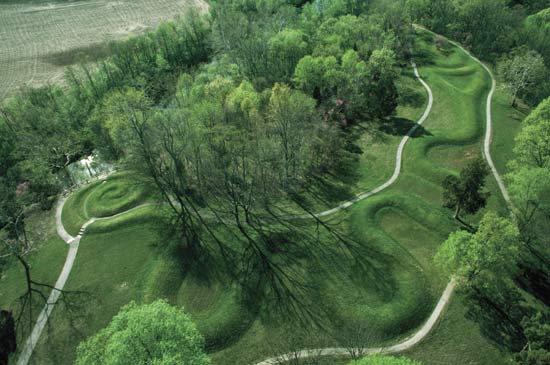 |
| An areal photo of a group of effigy mounds found in the Effigy Mount National Monument area. |
Geertz's definition of religion: "A system of symbols which acts to establish powerful, pervasive, and long-lasting moods and motivations in men by formulating conceptions of a general order of existence and clothing these conceptions with such an aura of factuality that the moods and motivations seem uniquely realistic."
A: As a sort of disclaimer, we will never truly know the reasons and thoughts behind the construction of effigy mounds. That being said, I am of the opinion that they were more than burial sights or art work. I take this position from looking at other ancient earth-based religions and spiritualities, in particular the ancient Irish idea and importance of the three realms of Sky, Land, and Sea, which correlate with categories (or "realms," as the book puts it) that the effigies are put into: air, earth, and water. These sorts of similarities bring me to firmly believe that these mounds (and their depictions) should be thought of in the realms of both spiritually and religiously relevance.
I doubt that we can ever fully know what these symbols mean spiritually, but my guess as far as religious symbols would be that these mounds represented the needs or traits of the tribe who built them. For example, think of how in some places there would be a number of bird mounds, but then one or two bears or snakes built as well. It seems sort of like an equation, doesn't it? Perhaps they were trying to draw in the power of "air" or "bird," but needed to balance it out with "earth" or "water." Or, maybe, as the book mentioned, it had to do with the status of the tribe. Maybe a surplus of bird mounds represented a warrior clan. In either of these ways, I think the symbols could (and would, if these hypotheses were proven true) provide a common mindset among those who made them, and certainly show some sort of uniformity.
 |
| A magnificent serpent in Ohio. |
I agree with your idea about the depth of these mounds. These mounds are too organized, and meaningful to be some random buries of Native Americans. And i think the connections you made between Irish concepts and Indian mounds are very interesting; maybe it is helpful for us to figure out more deeper meaning in the Indian Mounds.
ReplyDeleteI think, these mounds are transforming not only in their appearance, but in their inner meanings as well, from Conical mounds to effigy mounds.
The link you made between the divisions of earthly realms (land, sea and air) with other earth based spiritualties was extremely insightful. The illustration of the need for balance in effigy building is also a very interesting idea to run with. The religious significance of these mounds, or good places to start reasoning about these ideas, seems accessible through your analysis of their characteristics. Especially the use of the effigy mounds as status symbols and burial spots to "establish powerful, pervasive, and long-lasting moods". I think the only thing you neglect to mention is the waxing and waning between all of these features. The flexibility of all these practices make them truly religions, as they can me shaped and molded to fit the needs of their needs.
ReplyDelete